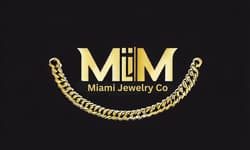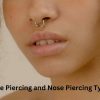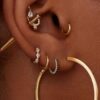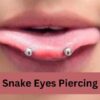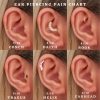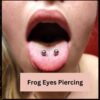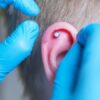Piercing
What is Nipple Piercing Crust: How Much is Normal?
Body piercings are a global phenomenon, a form of self-expression that transcends cultures and societies. They’ve moved beyond the realms of subcultures and countercultures, becoming a common sight in the mainstream world. The choice to have a body piercing is deeply personal, often a symbol of one’s individuality or a milestone. Among these, nipple piercings have gained particular popularity. Aesthetically bold and subtly rebellious, they offer a unique way to express personal style and confidence.
Contents
What is Nipple Piercing Crust
So, what exactly is nipple piercing crust?
It’s a common and natural part of the healing process. As your body works to heal the piercing, it produces lymph fluid which dries and hardens around the piercing site, forming a crust. While it might look concerning, it’s a standard aspect of healing.
Why Understanding Aftercare is Crucial
Understanding the various stages of healing, including the formation of crust, is crucial to taking proper care of your piercing. Knowing what’s normal and what’s a sign of trouble can be the difference between a smoothly healed piercing and one fraught with complications. And this starts with understanding the body’s response to a new piercing.
The Science Behind Nipple Piercings
The Body’s Response to a Piercing
When a piercing needle punctures the skin, it creates a wound. The body’s immediate response is inflammation, which helps to protect the area and start the healing process. This is why you’ll often see redness and swelling around a new piercing.
Immediate Body Response: Inflammation and Healing
The initial inflammation triggers the body’s immune system, calling white blood cells to the wound site to fight potential infections. In the early stages of healing, it’s normal to experience some discomfort, redness, and even a heat sensation around the piercing.
Role of the Immune System in Healing Piercings
The immune system plays a key role in the healing process. It not only fights off any potential infections but also helps in the creation of new skin cells to close the wound. As part of this process, the body produces lymph fluid that may cause some crustiness around the piercing.
The Role of the Lymphatic System in Healing
The lymphatic system, a crucial part of the body’s immune response, is also highly involved in the piercing healing process.
Understanding Lymph and its Functions
Lymph is a clear-to-yellowish fluid produced by the body, and it’s filled with proteins, minerals, and white blood cells. Its primary function is to carry these white blood cells throughout the body to help combat infections.
How Lymph Contributes to Crust Formation
After a new piercing, lymph fluid helps to clean and heal the wound. When this fluid reaches the surface of the wound and is exposed to air, it dries and forms a crust around the piercing site. This crust is a normal part of the healing process and an indication that your body is doing its job to heal the wound.
Why Do Nipple Piercings Crust?
The Healing Process and Crust Formation
Piercing crusts are not only normal, but they are also a crucial part of the healing process. As we mentioned earlier, crusts form when lymph fluid dries at the piercing site.
Timeline of Crust Formation
Crusting often begins shortly after the piercing is done and can last for several weeks or even months. You might notice the formation of a hard, somewhat brittle substance around your jewelry. It’s important to remember that this is a natural and expected response to a body piercing.
The Normalcy of Crust During Healing
Crusting is an integral part of the body’s healing process. While the sight of crust might seem alarming, especially to first-time piercees, it is typically a positive sign that your body is working hard to repair the piercing wound. As long as the crust isn’t accompanied by severe pain, excessive redness, or a foul odor, there’s usually no reason for concern.
Bacterial Causes for Crusting
While crust is often a sign of healing, it can also indicate a bacterial presence at the piercing site.
Good Bacteria vs Bad Bacteria: Understanding the Difference
It’s crucial to understand that not all bacteria are harmful. In fact, our bodies are home to trillions of good bacteria that help us maintain health. Similarly, the piercing site also hosts a mix of good and bad bacteria. The good ones help in healing, while the bad ones can cause infections if they multiply uncontrollably.
When Bacteria Contribute to Crust Formation
The crust around your piercing can contain both good and bad bacteria. Good bacteria contribute to the healing process, and their presence in the crust is normal. However, if you notice an increase in crust formation along with symptoms like redness, swelling, or a foul smell, it might suggest an overgrowth of harmful bacteria, warranting medical attention.
External Factors Affecting Crust Formation
Certain external factors can impact the healing of your piercing and the formation of crust.
Impact of External Environment on Healing Piercings
Environmental factors like dust, allergens, and pollutants can potentially irritate your piercing and affect the healing process. It’s crucial to keep your piercing clean and minimize exposure to potential irritants, especially in the early stages of healing.
Role of Personal Hygiene in Crust Formation
Maintaining personal hygiene is critical in piercing aftercare. Regularly cleaning the piercing site with a saline solution can help control the formation of crust, reducing the chances of infection.
How Much Crusting is Normal?
Early Stages of Healing and Expected Crusting
In the early stages of healing, some amount of crusting is to be expected.
What to Expect in the First Week
During the first week, your body initiates the healing process, and you may notice a fair amount of crusting. There might also be mild swelling and tenderness around the piercing site.
How Crust Changes in the First Month
As the weeks progress, the crust will change. By the end of the first month, the crust should start to decrease as the piercing wound heals.
Later Stages of Healing and Crust Reduction
Over time, as your body continues healing the piercing, the crusting should reduce.
Markers of Healing Progress
Signs of healing progress include a reduction in redness, swelling, and the amount of crust formed around your piercing.
When to Expect Crust to Disappear Completely
Typically, crust around a nipple piercing may take a few months to disappear completely, although this can vary depending on personal healing rates and how well you’ve cared for your piercing.
Variation in Crust Amounts Among Individuals
Just as we all are unique, so too are our bodies’ responses to piercings.
Why Everyone’s Piercing Experience is Different
Factors like your overall health, lifestyle habits, and even genetics can affect how your body heals a piercing, which in turn can influence the amount and duration of crust formation.
Factors that Influence Individual Healing Variations
Diet, sleep, stress levels, and personal hygiene all play a role in the healing process. Ensuring you have a balanced diet, adequate sleep, low stress levels, and maintaining cleanliness can help your body heal more efficiently.
When Should You Worry?
Identifying Excessive Crust
While some crust is normal and a good sign of healing, there can be such a thing as too much crust.
What Counts as ‘Excessive’ Crust
Determining what counts as ‘excessive’ can be somewhat subjective as each person’s healing process is unique. However, if you notice a thick, constant buildup of crust that seems disproportionate compared to the initial weeks after piercing, this could be a sign of a problem.
Why Excessive Crust is a Problem
Excessive crust could indicate that your body is fighting an infection or reacting to an irritant. In such cases, the crust might be accompanied by other symptoms, such as redness, swelling, or an unpleasant odor.
When Crust is Accompanied by Pain or Discomfort
Pain or discomfort in the nipple piercing area, especially if it persists or worsens, should be cause for concern.
Understanding Your Body’s Pain Response
Your body uses pain as a signal to alert you of potential problems. In the context of piercings, persistent or worsening pain can be a sign that the piercing isn’t healing properly or that an infection might be setting in.
When to Seek Help for Painful Crust
If your nipple piercing crust is causing significant discomfort or pain, it’s advisable to seek medical attention or consult a professional piercer. They can help identify if there’s an underlying issue that needs to be addressed.
Other Warning Signs to Look For
Apart from excessive crust and pain, there are other signs that something might be amiss with your piercing.
Recognizing Infection: Beyond the Crust
Infection signs may include persistent redness, swelling, warmth at the piercing site, or a foul odor. In some cases, you might also notice a yellow or green discharge, which is different from the usual whitish or clear crust.
When Crust Indicates Other Underlying Issues
If the crust around your nipple piercing is dark, bloody, or unusually persistent, it might indicate complications such as a piercing rejection or a more severe infection. These signs should not be ignored, and medical attention should be sought promptly.
Care and Cleaning for Your Nipple Piercing
Ideal Cleaning Procedure
Proper cleaning of your nipple piercing can go a long way in ensuring a smooth healing process.
Step-by-Step Guide to Cleaning Your Piercing
- Wash your hands thoroughly with an antibacterial soap.
- Prepare a saline solution by dissolving 1/4 teaspoon of non-iodized sea salt in a cup of warm distilled or bottled water.
- Soak a clean cotton ball in the saline solution and gently dab it around the piercing.
- Rinely with warm water to remove any leftover saline solution.
- Pat the area dry with a clean towel or paper towel.
Repeat this process twice a day during the healing period.
Tips for Cleaning Crust Safely and Effectively
Never pick or scratch at the crust around your piercing as it can cause injury and introduce bacteria into the wound. Instead, soften the crust by soaking it in saline solution, allowing it to naturally detach during cleaning.
Products to Use and Avoid for Cleaning
Knowing which products to use and which to avoid can ensure your cleaning routine is safe and effective.
Navigating Piercing Aftercare Products
Use a saline solution for cleaning as it’s gentle and mimics your body’s natural fluids. Avoid alcohol, hydrogen peroxide, or antibiotic creams as these can be too harsh and can delay healing.
Why Some Products are Harmful for Fresh Piercings
Some products can dry out the skin around your piercing or kill healthy bacteria that aid in the healing process. Others may cause allergic reactions, leading to irritation and prolonged healing times.
Lifestyle Considerations for Piercing Care
Taking care of a fresh piercing extends beyond just cleaning.
Making Adjustments for Your New Piercing
You may need to adjust some lifestyle habits for your piercing. For example, if you’re a side or stomach sleeper, try to sleep on your back to avoid pressure on the piercing.
Sleep, Clothing, and Other Lifestyle Factors to Consider
Opt for loose, breathable clothing to avoid irritation. It’s also recommended to keep your bed linens clean to minimize the risk of infection.
Potential Complications
While most nipple piercings heal without complications, it’s important to be aware of potential issues that may arise.
Signs of Infection
It’s crucial to recognize the signs of an infection early to get appropriate treatment.
Recognizing the Symptoms of an Infected Piercing
The signs of an infected piercing may include increased pain, redness, and swelling around the piercing site. The appearance of yellow or green pus, and a high temperature are also warning signs.
Why Prompt Treatment for Infections is Critical
Prompt treatment for infections is critical to prevent complications. An untreated infection can lead to abscesses or even sepsis, a serious systemic infection.
Piercing Rejection or Migration
Piercing rejection or migration is when your body tries to push the piercing out, like a splinter.
What Piercing Rejection Looks Like
Signs of piercing rejection include the piercing hole looking larger, jewelry hanging differently, redness, itching, and a thinning layer of skin between the jewelry and the surface.
How to Respond to a Migrating Piercing
If you suspect your piercing is rejecting or migrating, it’s important to seek professional help. They may suggest removing the jewelry and letting the area heal before attempting a new piercing.
Other Possible Complications
There are other, less common complications that you should be aware of.
Uncommon but Serious Piercing Risks
Uncommon but serious piercing risks can include allergic reactions to the jewelry material, nerve damage, and scarring. In rare cases, a poorly done piercing can lead to more serious complications like mastitis or breast tissue damage.
Ensuring Your Piercing Heals Safely
To ensure your piercing heals safely, follow the aftercare instructions provided by your piercer, keep the area clean, and monitor for signs of complications.
Seeing a Professional
When to Seek Professional Help
There are times when you may need to seek professional help with your piercing.
Navigating the Decision to See a Professional
If you’re noticing signs of infection, rejection, or other complications, or if you’re unsure about something, it’s best to consult with a piercing professional. It’s better to err on the side of caution.
Preparing for Your Visit to a Piercing Professional
When preparing for your visit, jot down any symptoms or changes you’ve noticed, and any questions you may have. This will help you get the most out of your consultation.
What to Expect from a Professional Consultation
A professional consultation can help you understand what’s happening with your piercing and guide you on next steps.
Typical Piercing Consultation Process
During a consultation, the professional will examine your piercing and ask about your symptoms and aftercare routine. They may then give advice or treatment recommendations based on their assessment.
Making the Most of Your Professional Consultation
To make the most of your consultation, be open and honest about your symptoms and concerns. Don’t hesitate to ask questions about anything you’re unsure of.
Resources
FAQs
Below are some frequently asked questions related to nipple piercings and crust formation:
Do nipple piercing crusties ever go away?
Yes, nipple piercing crusties will eventually go away as your body completes the healing process. The duration of this can vary from person to person, but generally, it can take anywhere from several weeks to a year or more.
Should I leave the crust on my piercing?
It’s best not to forcibly remove crust from your piercing as this can cause irritation and potentially lead to infection. However, when you clean your piercing, any softened crust may come off naturally.
How do you clean nipple crust?
Nipple crust can be cleaned gently with a saline solution. Moisten a cotton swab with the saline solution and gently wipe around the piercing. Avoid using alcohol or hydrogen peroxide, which can delay healing.
Why is my piercing still crusty after a year?
If your piercing is still producing crust after a year, it may indicate a low-grade infection or an allergic reaction to your jewelry. However, some bodies take longer to heal. If you’re concerned, it’s best to seek advice from a piercing professional.
How long do piercing crusties last?
Piercing crusties typically last throughout the healing process, which can be several weeks to a year or more depending on the individual and the specific piercing. If your piercing continues to produce crust beyond the typical healing period, consult with a piercing professional.
Is it Normal For Your Nipple Crust to Be Bloody?
In the early stages of healing, it can be normal to see a bit of blood mixed in with your nipple piercing crust. This is because the body is still dealing with the initial trauma of the piercing and is working hard to heal the area. However, if you’re noticing consistent or large amounts of blood, or if the bleeding continues beyond the early healing stages, it could be a sign of a complication, such as infection or the jewelry causing trauma to the piercing site. In such cases, it’s best to seek professional advice.
Conclusion
Nipple piercing crust is a natural part of the healing process, but understanding what’s normal and what’s not can ensure your piercing heals safely and healthily. Listen to your body and don’t hesitate to seek professional advice if you’re ever in doubt. Remember, an informed piercing enthusiast is a safe one.

Camila Luna is a passionate jewelry enthusiast and content creator at Miami Jewelry Co. With a focus on providing high-quality, Miami-style jewelry, Camila and her team specialize in a wide range of jewelry that includes bracelets, necklaces, earrings, and more
